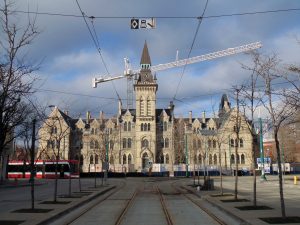
PHOTO BY BRIAN BURCHELL/GLEANER NEWS FILE PHOTO: City of Toronto senior planner Barry Brooks said that one aim of the Bloor Corridor/Annex Block Study is to “protect the significant view of the historical building (above) at 1 Spadina Cres. We are trying not to distract from the spire of that building.”
By Annemarie Brissenden
The city has responded to a developer’s application to build what many have termed a “vertical rooming house” at 316 Bloor St. W. with a development of its own: the Bloor Corridor/Annex Block Study.
“Two applications led us to believe that there is a certain amount of development pressure in the Annex,” explained Barry Brooks, a senior planner with the City of Toronto’s Community Planning Division.
Brian Burchell, chair of the Bloor-Annex BIA (who also publishes this newspaper), said he recognizes the “need to have a plan [like this] and funnel developer applications through it. Otherwise the city’s playing catch up.”
The study, presented at a well-attended community meeting in late June, was initiated out of Joe Cressy’s (Ward 20, Trinity-Spadina) office with input from several local residents’ associations.
The hope is it will lead to an Official Plan amendment that will strengthen the Bloor Corridor Visioning Study — which sets out a road map for Bloor Street West between Avenue Road and Bathurst Street that incorporates guidelines for land use, built form, transportation, community services, etc. — with more detailed guidelines relating to tall building heights, green space, separation between buildings, and laneways.
It also aims to protect the historical vista of the former home of Knox College at 1 Spadina Cres., stating that “buildings should not be built to a height that would detract from the silhouette of [the heritage] building, as viewed from College Street.
“In an area like Bloor Street, where we are experiencing a lot of development pressure, initiating plans like this is critical,” added Cressy, “so we are not constantly at the whim of developers”.
He characterized the application of 316 Bloor West Toronto Developments Ltd. to build a 42-storey mixed-use building at the northwest corner of Bloor Street West and Madison Avenue as “aggressive” and “out of context with the city’s plans for the neighbourhood [as detailed] in the Bloor Corridor Visioning Study”.
Current zoning allows for buildings to reach a height of 18 metres; the applicant’s proposed tower would stretch to 132 metres and consist largely of one-bedroom and studio units.
“It’s the density. We’d like to see a mix of units, so we can get families moving in as well”—Edward Leman, ARA
The city’s preliminary report on the application characterized the overall density and massing of the proposed development as “excessive” and noted “this density and this form is clearly not representative of the norm for this area”.
The developer has appealed directly to the Ontario Municipal Board (OMB).
“We’re strongly opposed,” said Edward Leman. He’s the co-chair of the planning and zoning committee of the Annex Residents’ Association, which along with the city is a party at the OMB for this file. “We didn’t want a massive dense student residence in the Annex.”
Although Burchell countered that “I don’t think it’s reasonable for residents to be concerned about the prospect of student housing when they move in next to the University of Toronto,” he did acknowledge that “it is important to get the right balance. Height and density do matter.”
For Leman, that’s exactly the point.
“It’s the density. [It would be different] if it was a 12- or 10-storey building. We’d like to see a mix of units, so we can get families moving in as well.”
“Intensification along the subway makes sense for the city as a whole,” said Burchell, “but it has to be managed properly. The developer [of 316 Bloor St. W.] has failed to engage the community meaningfully with respect to its plans.”
“It’s cynical the way the developer did it,” said Leman. “They didn’t formally consult with the councillor, and held a disappointing pro forma community meeting” in April of 2015.
Burchell noted that there has been a marked difference in approach between 316 Bloor West Toronto Developments Ltd. and Westbank Projects Corp., which is developing a large parcel of land that includes Honest Ed’s and Mirvish Village at Bloor and Bathurst streets.
“The BIA has witnessed in the last three years two applications that bookend our territory: Westbank and 316 Bloor. The two developers could not be more different with respect to the level of engagement with the city and community. It’s striking.
“I prefer Westbank with respect to its approach.”
The Bloor Corridor/Annex Block Study is expected to go before community council in October, and Toronto City Council in November.
READ MORE:
NEWS: “Vertical rooming house” rejected (May 2015)
Catching up with history (May 2014)
